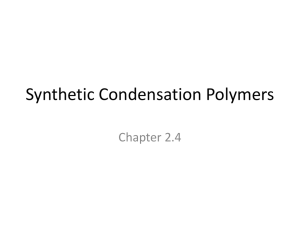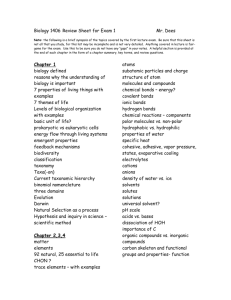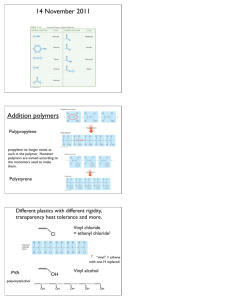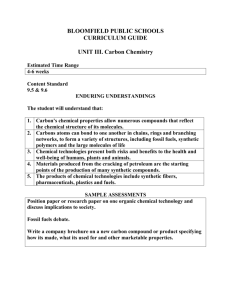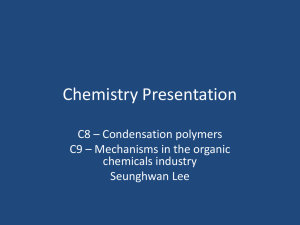CHAPTER 2: Polymers, Plastics, Nylons and Food
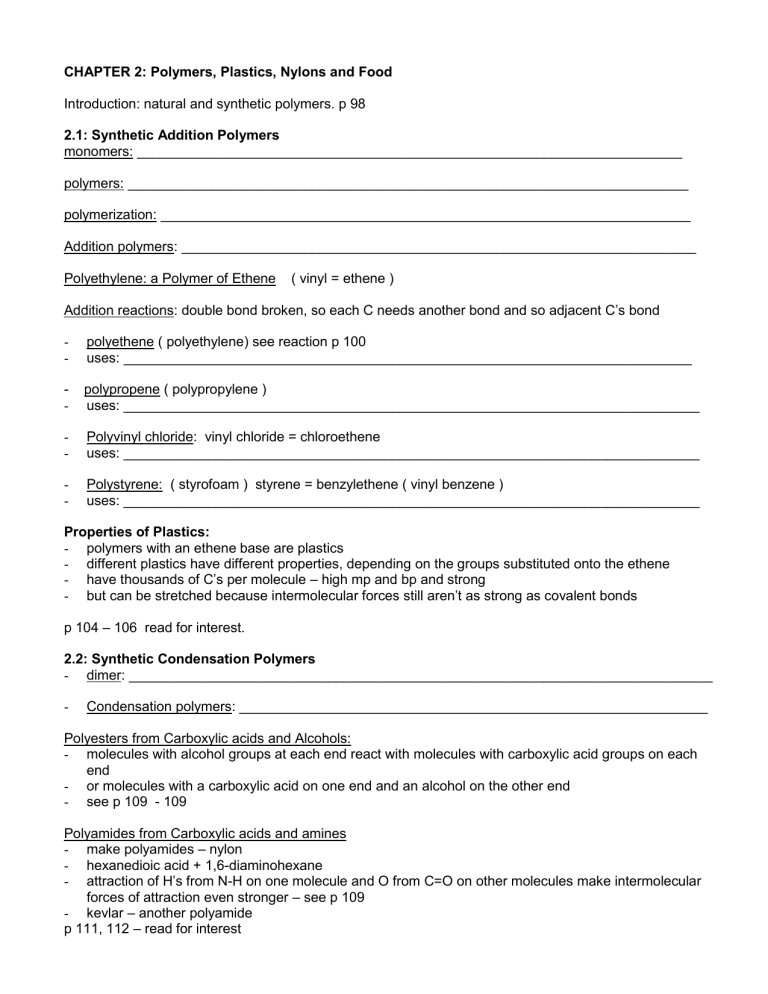
CHAPTER 2: Polymers, Plastics, Nylons and Food
Introduction: natural and synthetic polymers. p 98
2.1: Synthetic Addition Polymers monomers: _______________________________________________________________________ polymers: _________________________________________________________________________ polymerization: _____________________________________________________________________
Addition polymers: ___________________________________________________________________
Polyethylene: a Polymer of Ethene ( vinyl = ethene )
Addition reactions : double bond broken, so each C needs another bond and so adjacent C’s bond
polyethene ( polyethylene) see reaction p 100
uses: __________________________________________________________________________
- polypropene ( polypropylene )
uses: ___________________________________________________________________________
Polyvinyl chloride: vinyl chloride = chloroethene
uses: ___________________________________________________________________________
Polystyrene: ( styrofoam ) styrene = benzylethene ( vinyl benzene )
uses: ___________________________________________________________________________
Properties of Plastics:
polymers with an ethene base are plastics
different plastics have different properties, depending on the groups substituted onto the ethene
have thousands of C’s per molecule – high mp and bp and strong
but can be stretched because intermolecular forces still aren’t as strong as covalent bonds p 104 – 106 read for interest.
2.2: Synthetic Condensation Polymers
dimer: ____________________________________________________________________________
Condensation polymers: _____________________________________________________________
Polyesters from Carboxylic acids and Alcohols:
molecules with alcohol groups at each end react with molecules with carboxylic acid groups on each end
or molecules with a carboxylic acid on one end and an alcohol on the other end
see p 109 - 109
Polyamides from Carboxylic acids and amines
make polyamides – nylon
hexanedioic acid + 1,6-diaminohexane
attraction of H’s from N-H on one molecule and O from C=O on other molecules make intermolecular forces of attraction even stronger – see p 109
kevlar – another polyamide p 111, 112 – read for interest
2.3: Contact Lenses – read for interest
2.4: Proteins – natural polyamides
amino acids: amine group and carboxyl group both attach to the same carbon see p 117
two isomers of amino acids – L and D - L only exist naturally
Polypeptides from amino acids: polypeptides = proteins
peptide bond = amide bond
polypeptides = natural (made by cells) polyamides = proteins
Artificial Sweeteners: Health Risk or Health Benefit ?
can be used to decrease sugar consumption for overweight people, decrease tooth decay and increase food choices for diabetics
aspartame – sweet, digests to form natural amino acids and methanol
methanol – oxidized to form methanal – formaldehyde – changes protein function!
methanal oxidized to form methanoic acid – interferes with mitochondrial function in cells
methanal and methanoic acid build-up in optic nerves can cause irreversible damage – blindness
but: small amounts of methanol in fruits, vegetables, beer, wine
so: aspartame deemed “safe” if not too much is taken per day
So: what amount is safe?
read the rest of the section for interest
2.5: Starch and Cellulose- Polymers of Sugars
Carbohydrates: = Cx(H2O)y = hydrated carbon
ring structure: the OH gps are fixed above or below the ring and so the properties are affected
disaccharides: high mp and bp and soluble in water: many polar OH gps
Starch for Energy: Cellulose for support
glucose molecules linked with condensation reaction to form chain – see diagram p 127
if chain has U-shaped ether bonds, then starch is formed
if ether bonds are angled up, cellulose is formed – not soluble in water and we have no enzyme to digest it
2.6: read for interest.
2.7: Fats and Oils
Fatty acids: long C chains with an carboxylic acid group on the end
Triglycerides - 3 fatty acids attach to the OH gps on a glycerol ( 1,2,3-propanetriol) to form 3 ester bonds by condensation
Saponification: reverse the ester – forming reaction with strong hydroxides (NaOH) to reform the alcohol, glycerol. and the Na salt of the fatty acids – soap
the acid end is soluble in water and the C-chain part is soluble in oils and grease
-
Fats and oils: oils if double bonds in C chain because chains can’t get close easily and so less intermolecular bonding so lower mp and bp p 144 “Make a Summary”: should be able to do this
Self Quiz: all except topics I have omitted
Problem Set: p 146 – 147 # 1, 2, 5 ( write condensation reaction only ), 6b, 9, 10a, 12, 13, 14, 22a,c.
